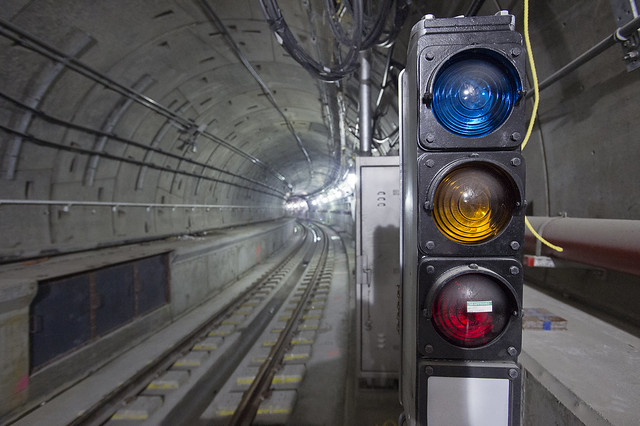Over the past two years, the disused Rockaway Beach Branch right-of-way has creeped into the news largely because a group of Queens residents want to turn it into a park. The group has received a half a million dollars from the state to study their proposal and are engaged in a design contest to produce renderings of the park. Since land acquisition costs are high and pre-existing rights of way rare in New York City, I’ve resisted this so-called QueensWay plan without at least a comparable study assessing rail feasibility.
As yet, Assemblyman Phillip Goldfeder has stepped up to lend his voice for rail reactivation and a few transit advocates have as well, but the dollars to study a plan aren’t in place. The QueensWay is sexy; rail running through some backyards that encroach onto the right of way is intrusive. It’s a classic and never-ending development debate and one into which the city and MTA have yet to wade.
That said, toward the end of the MTA’s 20 Year Needs Assessment is this paragraph:
Utilizing Available Rail Rights-of-Way: One challenge in providing for non-core-based travel is the availability of travel corridors supporting radial routes linking existing subway, bus and rail lines. A possible option is the utilization of abandoned or underutilized Rights of Way such as the LIRR Bay Ridge Branch (linking southern and eastern Brooklyn with Central and northern Queens) or the abandoned Rockaway Beach Branch (linking Howard Beach and Ozone Park with Woodhaven) as transverse routes linking radial subway lines. Conversion of existing ROWs, where a solution to an identified travel need can be defined, could help reduce land acquisition and construction costs, and facilitate construction time in densely developed areas.
Project proponents are excited by the MTA’s acknowledgment of the right-of-way even if previous documents have contained more extensive examinations of the disused lines. Goldfeder reiterated his support to DNA Info. “The MTA has done their part by putting the plan on the table,” he said. “Now, I have to go to Albany and fight for the funding — first for a feasibility study and then for the money to rebuild the line.”
QueensWay proponents rolled their eyes. “This was a one-sentence mention in a study over 130 pages in length,” Andrea Crawford, head of Friends of the QueensWay and Community Board 9 chair, said. “There is no discussion of an intent to even study the feasibility of building a new rail line utilizing the right of way. To leave this land fallow, to let it deteriorate further, is not beneficial for the residents of central Queens.”
If only the world were as black and white as Crawford’s. The MTA should explore the potential uses for underutilized rights of way, and QueensWay proponents should embrace any such study as it could put to rest, one way or another, the debate over the best way to use this space. Ultimately, Goldfeder will keep fighting the good fight, and we can enjoy a forward-looking feasibility study. Without one, we won’t know how best to use the Rockaway Beach Branch for the next generation of New Yorkers.

 The Second Ave. Sagas’ podcast “The Next Stop Is…” returns this week with a short episode for your listening enjoyment. Eric Brasure and I discuss
The Second Ave. Sagas’ podcast “The Next Stop Is…” returns this week with a short episode for your listening enjoyment. Eric Brasure and I discuss 
 Amidst much anticipation, Manhattan now has real-time bus tracking as the MTA unveiled BusTime for the County of New York. At around midnight this morning, BusTime — the MTA’s in-house-built, distance-based system — went live on nearly all Manhattan bus routes. The system is available on the web
Amidst much anticipation, Manhattan now has real-time bus tracking as the MTA unveiled BusTime for the County of New York. At around midnight this morning, BusTime — the MTA’s in-house-built, distance-based system — went live on nearly all Manhattan bus routes. The system is available on the web  New Jersey Transit’s response to Sandy is the story that just won’t die. It’s not quite a scandal, even though perhaps it should be, but the developments continue to trickle out thanks to reporting by Karen Rouse from The Record and Andrea Bernstein from WNYC. This should be a bigger black eye on the face of the Garden State and its governor, but so far, the scandal just won’t stick.
New Jersey Transit’s response to Sandy is the story that just won’t die. It’s not quite a scandal, even though perhaps it should be, but the developments continue to trickle out thanks to reporting by Karen Rouse from The Record and Andrea Bernstein from WNYC. This should be a bigger black eye on the face of the Garden State and its governor, but so far, the scandal just won’t stick.






 (FASTRACK)
(FASTRACK)



